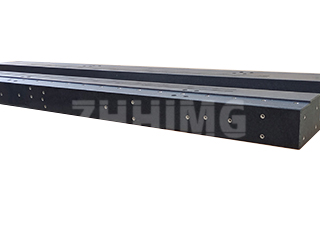The quality of the final assembled product depends not just on the granite itself, but on the meticulous adherence to stringent technical requirements during the integration process. Successful assembly of machinery incorporating granite components demands meticulous planning and execution that goes far beyond simple physical connection.
A critical first step in the assembly protocol is comprehensive cleaning and preparation of all parts. This involves the removal of residual casting sand, rust, and machining chips from all surfaces. For vital components, such as the internal cavities of large-scale machines, a coating of anti-rust paint is applied. Parts contaminated with oil or rust must be thoroughly cleaned with appropriate solvents, such as diesel or kerosene, and then air-dried. Following cleaning, the dimensional accuracy of mating parts must be re-verified; for instance, the fit between a spindle’s journal and its bearing, or the center distances of holes in the headstock, must be meticulously checked before proceeding.
Lubrication is another non-negotiable step. Before any parts are fitted or connected, a layer of lubricant must be applied to the mating surfaces, especially in critical areas like bearing seats within the spindle box or the lead screw and nut assemblies in lifting mechanisms. Bearings themselves must be thoroughly cleaned to remove protective anti-rust coatings before installation. During this cleaning, the rolling elements and raceways must be inspected for corrosion, and their free rotation must be confirmed.
Specific rules govern the assembly of transmission elements. For belt drives, the centerlines of the pulleys must be parallel and the groove centers perfectly aligned; excessive offset leads to uneven tension, slippage, and rapid wear. Similarly, meshed gears require their axis centerlines to be parallel and within the same plane, maintaining a normal engagement clearance with axial misalignment kept under 2 mm. When installing bearings, technicians must apply force evenly and symmetrically, ensuring the force vector aligns with the end face and not the rolling elements, thereby preventing tilting or damage. If excessive force is encountered during fitting, assembly must stop immediately for inspection.
Throughout the entire process, continuous inspection is mandatory. Technicians must check all connecting surfaces for flatness and deformation, removing any burrs to ensure the joint is tight, level, and true. For threaded connections, appropriate anti-loosening devices—such as double nuts, spring washers, or split pins—must be incorporated based on design specifications. Large or strip-shaped connectors require a specific tightening sequence, applying torque symmetrically from the center outwards to ensure uniform pressure distribution.
Finally, the assembly concludes with a detailed pre-start inspection covering the completeness of the work, the accuracy of all connections, the flexibility of moving parts, and the normalcy of the lubrication systems. Once the machine is started, the monitoring phase begins immediately. Key operating parameters—including movement speed, smoothness, spindle rotation, lubricant pressure, temperature, vibration, and noise—must be observed. Only when all performance indicators are stable and normal can the machine proceed to full trial operation, guaranteeing that the high stability of the granite base is fully utilized by a perfectly assembled mechanism.
Post time: Nov-20-2025

